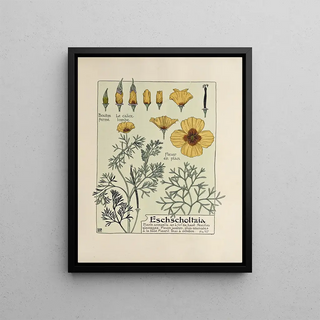Art print | Eschscholtzia - Maurice Pillard Verneuil


View from behind

Frame (optional)
In the vast universe of art, some works manage to capture the very essence of beauty and nature. "Eschscholtzia - Maurice Pillard Verneuil" is one of those creations that, through its delicacy and brilliance, transports the viewer into a world of colors and shapes. This piece, which evokes the blooming of the eponymous plant, embodies a perfect harmony between art and botany. It stands as an ode to nature, through vibrant hues and a carefully orchestrated composition. The art print of this work allows for rediscovering the magic of blooming, while offering a window into the fertile imagination of the artist.
Style and uniqueness of the work
Maurice Pillard Verneuil's style is undeniably marked by a decorative approach, where every detail is designed to create a unique atmosphere. In "Eschscholtzia," warm and luminous colors intertwine with remarkable finesse, while the fluid shapes of the petals seem to dance under the light. This piece is distinguished by its bold use of color, which evokes both lightness and depth. The shades of yellow, orange, and green blend harmoniously, creating a lively tableau that draws the eye and stimulates the imagination. The composition is both simple and complex, offering multiple levels of interpretation and an invitation to exploration. Each look at this work reveals new aspects, demonstrating the technical mastery of the artist and his ability to capture the essence of a fleeting moment.
The artist and his influence
Maurice Pillard Verneuil, an emblematic figure of Art Nouveau, knew how to marry art and nature with rare sensitivity. His work is part of an artistic movement that advocates harmony between man and his environment. Verneuil was influenced by the artistic currents of his time, but he also developed a personal style that is uniquely his own. His works, often inspired by flora, reveal a passion for organic shapes and natural motifs. By integrating botanical elements into his creations, he contributed to renewing the visual language.

Matte finish

View from behind

Frame (optional)
In the vast universe of art, some works manage to capture the very essence of beauty and nature. "Eschscholtzia - Maurice Pillard Verneuil" is one of those creations that, through its delicacy and brilliance, transports the viewer into a world of colors and shapes. This piece, which evokes the blooming of the eponymous plant, embodies a perfect harmony between art and botany. It stands as an ode to nature, through vibrant hues and a carefully orchestrated composition. The art print of this work allows for rediscovering the magic of blooming, while offering a window into the fertile imagination of the artist.
Style and uniqueness of the work
Maurice Pillard Verneuil's style is undeniably marked by a decorative approach, where every detail is designed to create a unique atmosphere. In "Eschscholtzia," warm and luminous colors intertwine with remarkable finesse, while the fluid shapes of the petals seem to dance under the light. This piece is distinguished by its bold use of color, which evokes both lightness and depth. The shades of yellow, orange, and green blend harmoniously, creating a lively tableau that draws the eye and stimulates the imagination. The composition is both simple and complex, offering multiple levels of interpretation and an invitation to exploration. Each look at this work reveals new aspects, demonstrating the technical mastery of the artist and his ability to capture the essence of a fleeting moment.
The artist and his influence
Maurice Pillard Verneuil, an emblematic figure of Art Nouveau, knew how to marry art and nature with rare sensitivity. His work is part of an artistic movement that advocates harmony between man and his environment. Verneuil was influenced by the artistic currents of his time, but he also developed a personal style that is uniquely his own. His works, often inspired by flora, reveal a passion for organic shapes and natural motifs. By integrating botanical elements into his creations, he contributed to renewing the visual language.






